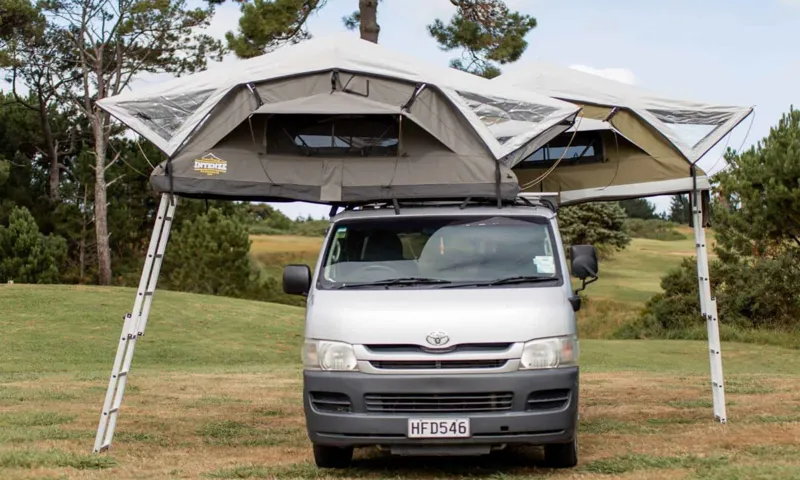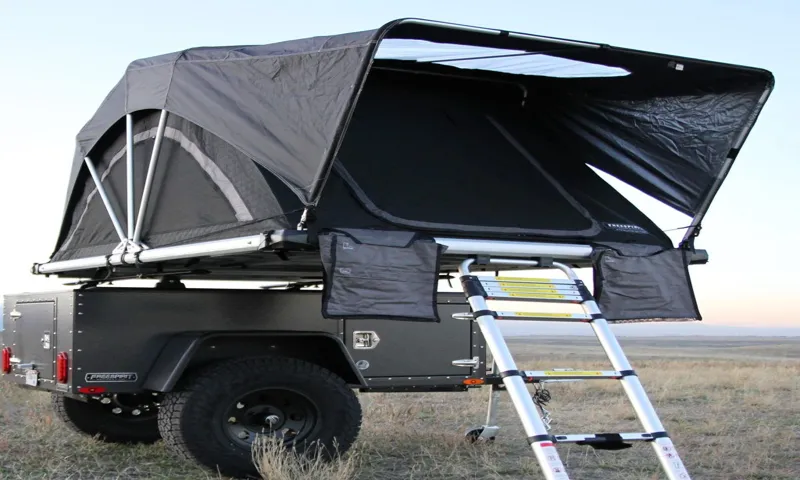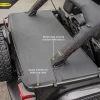Table of Contents
Introduction
How to dry a rooftop tent after it gets wet can be a common question for outdoor enthusiasts. After camping in rainy or damp conditions, it’s important to ensure that your rooftop tent is fully dried before packing it away to prevent mold and mildew growth. The first step is to open up the tent and remove any bedding or personal items.
Then, shake out any excess water or debris. Next, find a sunny spot to set up the tent and allow it to air dry completely. This can take several hours or even a whole day, depending on the weather conditions.
To speed up the drying process, you can use a fan or a portable heater. Just make sure to keep a safe distance to prevent any damage to the tent fabric. Once the tent is dry, make sure to check for any signs of moisture before packing it away.
By following these steps, you can ensure that your rooftop tent stays in good condition and ready for your next camping adventure.
What is a rooftop tent?
A rooftop tent, as the name suggests, is a tent that is mounted on top of a vehicle, usually a car or a 4x It is an innovative and practical solution for camping and outdoor enthusiasts who want to experience the great outdoors without the hassle of setting up a traditional tent on the ground. These tents are designed to be rugged, weather-resistant, and easy to set up, making them perfect for camping trips, road trips, and off-road adventures.
With a rooftop tent, you can sleep comfortably above the ground, away from bugs, rocks, and uneven terrain. It offers a unique camping experience and allows you to have a comfortable night’s sleep wherever you go. Whether you are exploring remote wilderness areas or simply camping in a crowded campground, a rooftop tent provides a convenient and cozy shelter that can be set up in a matter of minutes.
So, if you are looking for a convenient and comfortable camping solution, a rooftop tent might be just what you need.
Why do you need to dry your rooftop tent?
“Why do you need to dry your rooftop tent?” Introduction So you’ve just come back from an amazing camping trip with your rooftop tent, and now it’s time to pack everything up and head back home. But before you toss your tent into storage, there’s one important step you shouldn’t skip – drying it. You might be wondering why drying your rooftop tent is necessary.
After all, it’s just made to withstand the elements, right? Well, believe it or not, moisture is the enemy of your tent, and failing to dry it properly can lead to a whole host of issues down the line. In this blog post, we’ll explore why drying your rooftop tent is so important and what can happen if you neglect this crucial step. So grab a cup of coffee and let’s dive in!

Step-by-step guide on drying your rooftop tent
So, you just got back from an amazing camping trip and your rooftop tent is a bit damp from all the adventure. No worries, I’ve got you covered with a step-by-step guide on how to dry your roof top tent. First, start by finding a well-ventilated area to set up your tent.
It could be your backyard or a spot where there is a good amount of airflow. Next, open up all the windows and doors of the tent to allow for maximum air circulation. This will help to speed up the drying process.
If there are any wet or damp items inside the tent, remove them and hang them up separately to dry. Now, it’s time to let nature do its thing. Leave the tent to air dry for several hours or even overnight if necessary.
Make sure to check the weather forecast before leaving your tent unattended to avoid any unexpected rain showers. Once the tent is dry, give it a quick inspection to make sure there are no remaining damp spots. If you find any, use a towel or cloth to dry them off.
And that’s it! Your rooftop tent is now dried and ready for your next adventure. Remember, keeping your tent dry is important to prevent mold or mildew from forming, so be sure to follow these steps after every camping trip. Happy camping!
Step 1: Remove the rooftop tent from your vehicle
rooftop tent, drying, step-by-step guide, remove, vehicle So you’ve just returned from an epic camping trip with your rooftop tent, and now it’s time to give it a little TLC. The first step in preserving your tent and ensuring it stays in top-notch condition is to dry it properly. But where do you start? Don’t worry, we’ve got you covered with this step-by-step guide on how to dry your rooftop tent.
The first thing you’ll need to do is remove the rooftop tent from your vehicle. This may seem like an obvious step, but it’s an important one. By taking the tent off your vehicle, you’ll have easier access to all the nooks and crannies that need to be dried.
Plus, removing the tent will also prevent any potential damage to your vehicle while you work on drying it. Once the tent is off your vehicle, find a clean, dry area where you can lay it out. Make sure the surface is flat and free from dirt or debris.
You don’t want any unwanted particles getting stuck to your tent during the drying process. Next, open up all the tent windows, doors, and vents to maximize airflow. This will allow the moisture inside the tent to escape more easily.
You can also shake the tent gently to help loosen any trapped water or dirt. Now comes the fun part: exposing your tent to the sun. The sun’s rays will not only help to evaporate any remaining moisture, but it will also kill any potential mold or mildew.
Lay your tent out in a spot where it will receive direct sunlight for the majority of the day. If you’re concerned about UV damage, you can place a tarp or sheet over the tent to create a shady area. Throughout the drying process, it’s important to periodically check on your tent.
Step 2: Open up the rooftop tent
“Step 2: Open up the rooftop tent” After successfully removing your rooftop tent from the vehicle, the next step is to open it up. This may seem like a simple task, but it’s important to do it correctly to ensure your tent dries properly. Start by locating the zipper or velcro closure on your tent.
Carefully unzip or unfasten it to expose the interior. Before fully opening it up, take a moment to assess the area around you. Make sure there is enough space and that you’re opening the tent on a flat surface.
This will help prevent any potential accidents and ensure a smooth opening process. Once you’ve found the perfect spot, begin unfolding the tent by gently pulling it apart. Take your time and be mindful of any straps or buckles that may be holding the tent in place.
As you unfold the tent, gradually extend the telescoping ladder if your model has one. This will allow for easier access and make the tent more stable. Once the tent is fully opened, take a moment to inspect it for any signs of damage or wear.
Look for any tears, loose stitches, or broken zippers. It’s important to address these issues promptly to prevent further damage and ensure the longevity of your rooftop tent. Now that your tent is open, you’re ready to move on to the next step in the drying process.
Step 3: Remove the mattress and other accessories
In order to properly dry your rooftop tent, it’s important to remove all of the accessories first. Start by taking out the mattress and any other bedding or cushions that may be inside the tent. These items can trap moisture and prevent the tent from drying fully.
Place the mattress and other accessories in a well-ventilated area to allow them to air out. This will help prevent mold and keep your tent fresh and clean for your next outdoor adventure. Remember, proper maintenance is key to extending the life of your rooftop tent and ensuring its durability.
Step 4: Shake out any debris or dirt
In the process of drying your rooftop tent, step four involves shaking out any debris or dirt that may have collected during your camping adventures. After you have carefully removed the tent from the roof of your vehicle and unfolded it on a flat surface, take a moment to inspect the surface for any loose dirt or debris. This debris can include leaves, twigs, or even small pebbles that may have gotten caught inside the folds of the tent.
By shaking out the tent, you can ensure that it is free from any unwanted materials that could potentially damage the fabric or cause issues in the future. Give the tent a good shake in different directions to dislodge any trapped debris and create a clean surface for the drying process. By taking the time to remove any dirt or debris, you are not only prolonging the lifespan of your rooftop tent but also ensuring that it is clean and ready for your next outdoor adventure.
So, give it a good shake and get ready to move on to the next step of the drying process.
Step 5: Wipe down the fabric with a towel
drying your rooftop tent
Step 6: Air dry the tent
air dry rooftop tent Once you have thoroughly cleaned your rooftop tent, the next step is to ensure that it is properly dried before storing it. Air drying is the best method for this, as it allows for natural evaporation and prevents the growth of mold or mildew. To get started, find a well-ventilated area such as a backyard or patio where you can hang the tent.
Ideally, you want to choose a spot that receives plenty of sunlight and has good airflow. Begin by setting up the tent in a way that allows maximum exposure to the air. You can do this by opening all the windows and doors, as well as any vents or flaps.
This will help to release any moisture trapped inside the tent. If your rooftop tent has a rainfly, remove it and lay it out separately to dry. Next, use a clean cloth or sponge to wipe down any remaining moisture on the tent.
Pay special attention to seams, zippers, and corners where water tends to accumulate. This will help to speed up the drying process and prevent any water from pooling or stagnating. Now it’s time to let nature do its work.
Hang the tent in a way that allows it to fully air out. You can use clotheslines, trees, or even a rooftop rack. Make sure to spread out the fabric as much as possible to maximize airflow.
If the weather permits, leave the tent outside for a few hours or even overnight to ensure that it is completely dry. During the drying process, it’s important to periodically check the tent for any signs of dampness or moisture. If you notice any areas that are still wet, use a towel or cloth to blot them dry.
Step 7: Reassemble the rooftop tent
drying rooftop tent, reassembling rooftop tent, camping gear maintenance, rooftop tent care Now that you’ve successfully taken down your rooftop tent and have properly cleaned it, it’s time to move on to the next step: drying and reassembling your rooftop tent. Drying your tent thoroughly is essential in preventing mildew and mold from forming, ensuring that you can continue to use your tent for future camping adventures. Here is a step-by-step guide on how to properly dry your rooftop tent.
First, find a dry and well-ventilated area to set up your tent for drying. Make sure the area is free from direct sunlight, as prolonged exposure to the sun can damage the fabric of your tent. A shady spot in your backyard or a well-ventilated garage can be an ideal location.
Next, carefully lay out all the components of your rooftop tent, including the tent body, rainfly, and any detachable parts such as the ladder or annex. Ensure that all zippers are fully opened to allow for proper airflow during the drying process. Using a soft cloth or towel, gently wipe down the tent body and any other fabric parts to remove any excess moisture.
This step is especially important if you’ve had to clean any stains or spills off your tent during the cleaning process. Once you’ve wiped down the fabric, leave all the components of your tent to air dry naturally. Depending on weather conditions, this process can take anywhere from a few hours to a couple of days.
It’s important to exercise patience and allow the tent to dry completely before reassembling it. While the tent is drying, take this opportunity to inspect all the components for any damage or wear. Check the zippers, seams, and poles to ensure they are in good condition.
If any repairs are needed, make note of them and address them before reassembling the tent. Once the tent is completely dry, it’s time to reassemble it. Start by attaching the rainfly, following the specific instructions provided by the manufacturer.
Tips for drying your rooftop tent effectively
If you’re a proud owner of a rooftop tent, you probably know that keeping it dry is crucial to its longevity and overall performance. After a camping trip or during a period of rainy weather, it’s important to take the time to properly dry out your rooftop tent before storing it away. So, how can you effectively dry your roof top tent? One tip is to set it up in a well-ventilated area and unzip all the windows and doors to allow air circulation.
This will help to evaporate any moisture trapped inside the tent. You can also use a fan or open up the vehicle’s windows to facilitate drying. Another tip is to wipe down the tent fabric with a clean cloth to remove any excess water or moisture.
Lastly, make sure to check the weather forecast and choose a sunny and dry day to dry out your rooftop tent. By following these tips, you can ensure that your rooftop tent remains in excellent condition for many camping adventures to come. So, next time you’re packing up after a camping trip, be sure to take the time to dry out your roof top tent properly.
Tip 1: Choose a sunny and breezy location
When it comes to drying your rooftop tent after a camping trip, choosing the right location is key. Opt for a spot that is sunny and breezy to speed up the drying process. The sunlight will help evaporate any moisture that may have accumulated on the fabric, while the breeze will help facilitate air circulation and prevent any mildew or musty odors from developing.
Additionally, a sunny location will also help kill off any bacteria or germs that may be lingering on the tent. So, next time you’re drying your rooftop tent, find a sunny and breezy spot for optimal results.
Tip 2: Use a fan to speed up the drying process
drying your rooftop tent One of the challenges of camping is dealing with wet gear, especially when it comes to your rooftop tent. Nobody wants to sleep in a damp, musty tent. So, how can you speed up the drying process? One handy tip is to use a fan.
Setting up a fan near your tent can help circulate air and increase the rate of evaporation. This is especially useful if you’re camping in a humid or rainy environment. The fan will help dry both the inside and outside of the tent, ensuring that it’s ready for your next adventure.
Just make sure to position the fan in a way that it doesn’t blow directly onto the tent fabric, as this could potentially cause damage. So, next time you’re packing up your rooftop tent, don’t forget to bring a fan along to help you dry it quickly and effectively. Happy camping!
Tip 3: Clean and dry the tent regularly to prevent mold and mildew
One important aspect of maintaining your rooftop tent is ensuring that it is clean and dry. Regular cleaning helps prevent the growth of mold and mildew, which can damage the fabric and make your tent smell unpleasant. To effectively dry your tent, start by removing any dirt or debris from the surface.
You can use a soft brush or cloth to gently scrub away any stains or buildup. Once the tent is clean, it’s crucial to let it dry completely before storing it. This can be done by leaving it open in a well-ventilated area, preferably in direct sunlight if possible.
The heat from the sun will help evaporate any moisture trapped in the fabric. Remember to flip the tent over and allow both sides to dry thoroughly. Additionally, make sure the zippers are completely open to ensure proper airflow.
By following these tips, you can keep your rooftop tent in great condition and avoid the growth of mold and mildew.
Conclusion
In conclusion, drying your rooftop tent is a cinch when you follow these easy steps. Just like a cat finding the sunniest spot to nap in, your tent needs to be exposed to sunlight to fully dry. By flipping it upside down, utilizing gravity’s helping hand, and giving it a good shake, you’ll rid your tent of any lingering dampness.
Remember, patience is key – just like waiting for the punchline of a well-timed joke, you need to wait for nature to work its magic. So, don’t let your tent feel like a wet blanket, get out there, and let it bask in the sun, ensuring your next camping adventure is dry and delightful!”
FAQs
How do I properly dry my roof top tent after use?
To properly dry your roof top tent, you can follow these steps:
– Remove any excess dirt or debris from the tent.
– Open up all the windows and vents to improve air circulation.
– Use a clean, absorbent cloth or towel to wipe down any wet surfaces.
– Set up the tent in a well-ventilated area, preferably under direct sunlight, to allow it to dry naturally.
– If necessary, use a fan to speed up the drying process.
How long does it typically take for a roof top tent to dry?
The drying time for a roof top tent can vary depending on various factors such as weather conditions, humidity levels, and how wet the tent is. On average, it may take anywhere from a few hours to a day for the tent to completely dry.
Can I use a hairdryer or other heating devices to dry my roof top tent?
It is not recommended to use heating devices like hairdryers or heaters to dry your roof top tent. Excessive heat can damage the fabric and potentially cause fire hazards. It is best to let the tent dry naturally.
What should I do if my roof top tent gets wet while camping?
If your roof top tent gets wet while camping, try to dry it as soon as possible to prevent mold and mildew growth. Follow the steps mentioned in the answer to question 1 to properly dry the tent.
Is it necessary to dry the roof top tent before packing it up for storage?
Yes, it is highly recommended to dry your roof top tent thoroughly before packing it up for storage. Moisture trapped in the tent can lead to mold and mildew growth, causing damage to the fabric and other components.
Can I roll up my roof top tent without drying it?
It is not advisable to roll up your roof top tent without drying it first. This can lead to the growth of mold and mildew, affecting the lifespan and performance of the tent.
Are there any special care instructions for drying a canvas roof top tent?
Canvas roof top tents require special care when drying. Make sure to avoid direct sunlight as prolonged exposure can fade and weaken the fabric. Instead, choose a shaded area with good air circulation to dry the tent. Additionally, avoid using harsh detergents and chemicals when cleaning the tent as it can damage the canvas.



